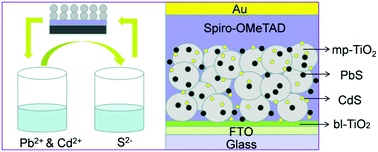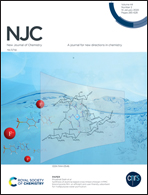Enhanced performance of all solid-state quantum dot-sensitized solar cells via synchronous deposition of PbS and CdS quantum dots†
Abstract
All solid-state quantum dot-sensitized solar cells (QDSCs) have become increasingly attractive owing to their ability to solve the issues of package difficulty and poor long-term stability. However, the commonly used colloidal lead sulfide (PbS) quantum dots (QDs) suffer from having a complicated synthesis with the use of high-temperature, harmful organic solvents and a protective atmosphere. In this work, the synchronous deposition of PbS and CdS QDs, realized through a facile successive ionic layer adsorption and reaction (SILAR), was proposed to construct efficient and stable solid-state QDSCs. This design concept affords two benefits: (1) the synchronous deposition of two sulfides suppresses the excessive growth of PbS QDs in the mesopores of films, thereby ensuring the efficient electron injection from PbS to TiO2; (2) the intimate interpenetration of two sulfides allows superior passivation of high-density defects on the surface of PbS QDs, which reduces the severe interfacial charge recombination. As a result, the solid-state (Pb,Cd)S QD-sensitized TiO2 solar cell achieved more than 5 times efficiency enhancement in contrast to the conventional PbS/CdS pattern based device. This work highlights the design of novel QD schemes for high performance solid-state solar cells.



 Please wait while we load your content...
Please wait while we load your content...